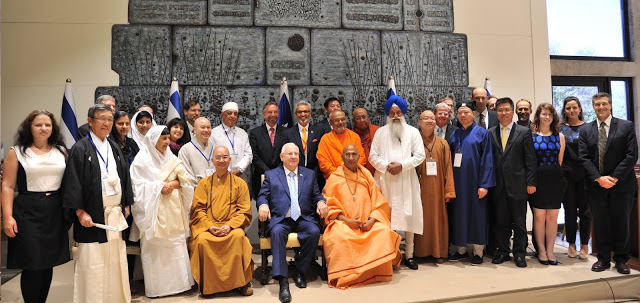| Representatives of diverse faiths attend the Israel Ministry of Foreign Affairs' conference. |
Founding faculty member, Arava Institute for Environmental Studies
The conference began with Israeli President Rivlin hosting us at Beit HaNassi, the President’s House. Over the next two days, sessions included exploring together "The Purpose and Place of Religion in our Societies," "Religion and Responsibility: The Vision of a Just Society," and "Repairing the World: The Role of Religious Leaders in Peace Making."
On a sunny August desert morning, I found myself invited by the Israel Ministry of Foreign Affairs to talk about the Arava Institute's research in solar energy at a conference of "Ancient Traditions Contemporary Realities: A Meeting of Israel-Asia Faith Leaders" in Jerusalem.
There were leaders from the Hindu, Jain, Buddhist, Zoroastrian, Sikh, Shinto, and Taoist religions, as well as a number of rabbis and Jewish scholars. It was a fascinating three-day encounter between Judaism and religions one does not often find itself in contact, much less dialogue, with. And that was exactly the reason the Israel Ministry of Foreign Affairs convened this gathering.
Too often we think of the monotheistic trinity of Judaism, Christianity, and Islam, and forget the other religions of the world, which represent some 2 billion people. To accommodate the dietary needs of the participants all the meals were vegetarian or vegan, including an all-vegan dinner at the King David Hotel!
 |
| Rabbi Michael Cohen |
The conference began with Israeli President Rivlin hosting us at Beit HaNassi, the President’s House. Over the next two days, sessions included exploring together "The Purpose and Place of Religion in our Societies," "Religion and Responsibility: The Vision of a Just Society," and "Repairing the World: The Role of Religious Leaders in Peace Making."
In a session titled "Safeguarding the Garden: The Ecology of Planet Earth in an Industrial Age" I gave the keynote talk, "Let There Be Light: Diversity as a Biblical Message." I opened with a presentation of the strong message of diversity found in the first 11 chapters of the Book of Genesis.
I then used the idea of diversity as a way to talk about the diverse student body we have at the Arava Institute. The second half of the talk focused on the solar research we do at the Institute in our Center for Renewable Energy and Energy Conservation, directed by Tareq Abu Hamed. The talk was very well received. The conference, like our work at the Arava Institute, showcased that when you bring together people from diverse multicultural backgrounds, the common striving for peace and sustainability shines through.
More on the Arava Institute
Meet the Israeli tree sprouted from a 2,000-year-old seed
Water trip through Israeli gives student hope for a dry, troubled region
More on the Arava Institute
Meet the Israeli tree sprouted from a 2,000-year-old seed
Water trip through Israeli gives student hope for a dry, troubled region
The new semester at the Arava Institute opened this week-- always an exciting experience. It is also one of our largest fall semesters in years.
We talk about the international students who make up part of the mosaic of our diverse student body. Most are from North America, but there are always others as well. This semester we have participants from Brazil, Argentina, Puerto Rico, Kenya, Denmark, Austria, Germany, and Italy. One outcome from the conference last week is that we hope to see in the future students from China, South Korea, Japan, Myanmar, India, and Taiwan, representing those many religions, also study with us at the Arava Institute.
Rabbi Michael Cohen teaches conflict resolution at Bennington College’s Center for the Advancement of Public Action (CAPA). As a founding faculty member of the Arava Institute, he continues to support its work from near and far. During the fall 2016 semester, which he is spending in Kibbutz Ketura with his wife Alison, he is teaching the course "The Bible as a Key to Environmental Thought," and blogging regular reflections on the Arava Institute and its surroundings.
This post originally appeared on the Arava Institute blog.


